Impact of Stigma for People with Mental Health Problems in the Workplace in England
Conduct a Narrative Literature Review with a front page, abstract, title and contents page, and chapters including an introduction.
38 Pages11488 Words58 Views
Added on 2023-06-11
About This Document
This literature review discusses the impact of stigma and discrimination on employees with mental health problems in the workplace in England. It highlights the barriers to mental health recovery and employment opportunities faced by such individuals. The review also discusses the types of mental disorders and the prevalence of mental illnesses among adults and youth.
Impact of Stigma for People with Mental Health Problems in the Workplace in England
Conduct a Narrative Literature Review with a front page, abstract, title and contents page, and chapters including an introduction.
Added on 2023-06-11
ShareRelated Documents
Running head: NARRATIVE LITERATURE REVIEW
Dissertation on the impact of stigma for people age 25 - 40 with mental health problem in the
work place in England
Name of the Student
Name of the University
Author Note
Dissertation on the impact of stigma for people age 25 - 40 with mental health problem in the
work place in England
Name of the Student
Name of the University
Author Note
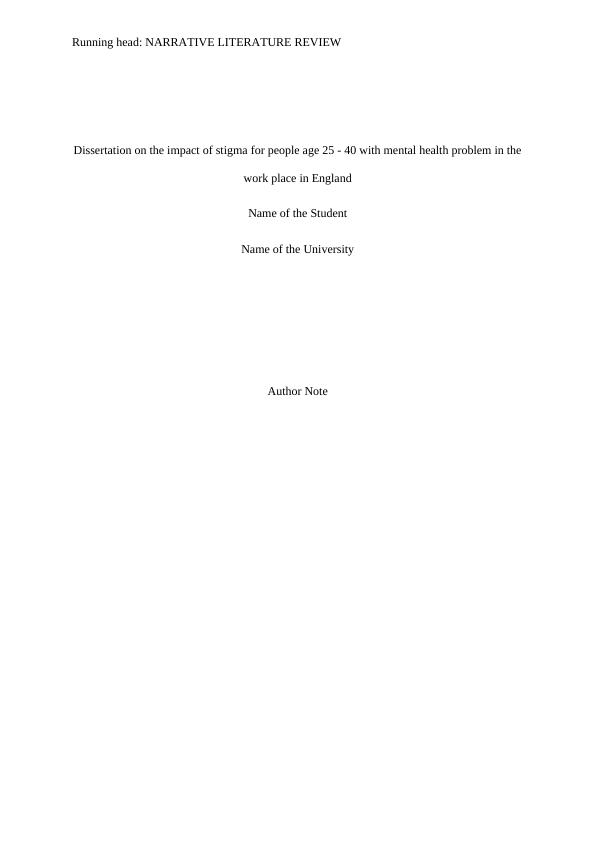
1NARRATIVE LITERATURE REVIEW
Abstract
There social ‘stigma and discrimination’ associated with mental disorders are widespread and
have been found to create major impacts on preventing individuals from accepting their
mental health problems, resulting in low rates of disclosure. Stigma and discrimination are
both a distal and proximate reason for employment inequities among people suffering from
mental disabilities. Such people often experience direct discrimination due to display of
prejudicial attitudes from their employers or workmates. They are also subjected to indirect
discrimination owing to their ‘historical patterns of disadvantage’, and ‘structural
disincentives’ against opportunities for ‘competitive employment’. Exclusion from the
workforce often erodes self-confidence, creates material deprivation, and results in the
manifestation of a persistent sense of marginalization and isolation among the affected
individuals. Reports from the affected people suggests that social stigma attached to mental
disorders make the difficulties worse and often act as significant barriers in the process of
mental recovery. The general stereotypes views on mental illness held by the society are
focused on the myth that mentally ill person are dangerous and violent and are at an increased
risk of posing harm to themselves and the surrounding people. In addition to reducing
chances for employment, such stigma impedes the process of securing appropriate mental
health services. This narrative literature review will discuss the stigma and discrimination
faced by employees at their workplace in England.
Keywords: mental illness, disorder, stigma, discrimination, employment
Abstract
There social ‘stigma and discrimination’ associated with mental disorders are widespread and
have been found to create major impacts on preventing individuals from accepting their
mental health problems, resulting in low rates of disclosure. Stigma and discrimination are
both a distal and proximate reason for employment inequities among people suffering from
mental disabilities. Such people often experience direct discrimination due to display of
prejudicial attitudes from their employers or workmates. They are also subjected to indirect
discrimination owing to their ‘historical patterns of disadvantage’, and ‘structural
disincentives’ against opportunities for ‘competitive employment’. Exclusion from the
workforce often erodes self-confidence, creates material deprivation, and results in the
manifestation of a persistent sense of marginalization and isolation among the affected
individuals. Reports from the affected people suggests that social stigma attached to mental
disorders make the difficulties worse and often act as significant barriers in the process of
mental recovery. The general stereotypes views on mental illness held by the society are
focused on the myth that mentally ill person are dangerous and violent and are at an increased
risk of posing harm to themselves and the surrounding people. In addition to reducing
chances for employment, such stigma impedes the process of securing appropriate mental
health services. This narrative literature review will discuss the stigma and discrimination
faced by employees at their workplace in England.
Keywords: mental illness, disorder, stigma, discrimination, employment
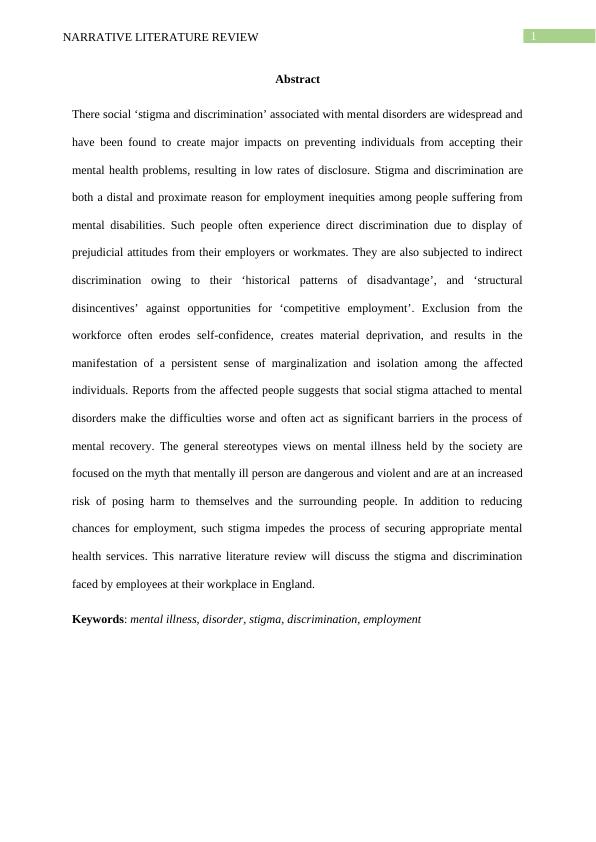
2NARRATIVE LITERATURE REVIEW
Table of Contents
Chapter 1: Introduction..............................................................................................................3
Chapter 2: Background and Rationale.......................................................................................7
Context of the study...............................................................................................................7
Rationale................................................................................................................................8
Chapter 3: Research Methodology...........................................................................................11
Research design....................................................................................................................11
Data collection method........................................................................................................12
Search strategy.....................................................................................................................13
Inclusion criteria...................................................................................................................14
Exclusion criteria.................................................................................................................15
Chapter 4: Main findings.........................................................................................................17
4.1 Employer’s attitudes towards people with mental illness in the workplace in England 17
4.2 The stigma and discrimination experienced by the mentally ill employees in the
workplace in England...........................................................................................................21
4.3 Government strategies and supported employment of employees with mental illness, in
England................................................................................................................................25
Chapter 5: Discussion and conclusion:....................................................................................29
References................................................................................................................................32
Table of Contents
Chapter 1: Introduction..............................................................................................................3
Chapter 2: Background and Rationale.......................................................................................7
Context of the study...............................................................................................................7
Rationale................................................................................................................................8
Chapter 3: Research Methodology...........................................................................................11
Research design....................................................................................................................11
Data collection method........................................................................................................12
Search strategy.....................................................................................................................13
Inclusion criteria...................................................................................................................14
Exclusion criteria.................................................................................................................15
Chapter 4: Main findings.........................................................................................................17
4.1 Employer’s attitudes towards people with mental illness in the workplace in England 17
4.2 The stigma and discrimination experienced by the mentally ill employees in the
workplace in England...........................................................................................................21
4.3 Government strategies and supported employment of employees with mental illness, in
England................................................................................................................................25
Chapter 5: Discussion and conclusion:....................................................................................29
References................................................................................................................................32
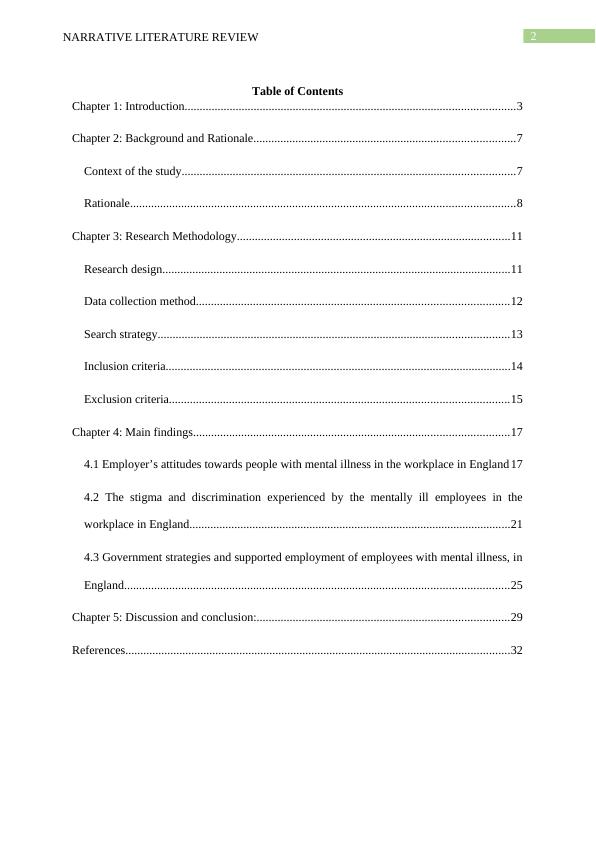
3NARRATIVE LITERATURE REVIEW
Chapter 1: Introduction
Mental illness or mental disorders refer to particular mental or behavioural patterns
that are responsible for causing significant impairment and distress, thereby affecting the
normal functioning of the affected individuals. These illness are either relapsing or might get
manifested in the form of a single episode. In other words, mental illnesses encompass health
conditions that involve a plethora changes in emotion, thinking, or behavior of a person.
Mental disorders are commonly associated with distress and functioning in family, social, or
work related activities (Whiteford et al. 2013). There exists more than 200 forms of mental
illnesses. Some of the most common types of mental disorders include bipolar disorder,
depression, schizophrenia, dementia, and anxiety disorders. The common symptoms often
include changes in the personality, mood, and personal habits of the affected person, which in
turn results in their social withdrawal.
Mental health problems are generally associated with excessive stress that can be
attributed to range of adverse situation or events. Showing similarities with diabetes, cancer,
and heart disease, mental illnesses get manifested in terms of physical, psychological and
emotional outcomes. In addition to environmental stresses, several biochemical imbalances,
genetic factors, or a combination of both might directly result in manifestation of mental
disorders (Maercker et al. 2013). According to DSM-IV, mental disorders is an umbrella term
that refers to psychological patterns or syndromes that are associated with painful symptoms,
thereby contributing to distress, disability or impairment in important areas of functioning,
increased risks of mortality and significant loss of autonomy and dignity. However, mental
illness excludes some of the most common responses that pertain to grief or sudden loss due
to death of a loved one. In addition to the definitions proposed by DSM-IV, changes have
been made in DSM-V that emphasise on the fact that mental health disorders generally reflect
presence of psychobiological conditions (American Psychiatric Association 2013).
Chapter 1: Introduction
Mental illness or mental disorders refer to particular mental or behavioural patterns
that are responsible for causing significant impairment and distress, thereby affecting the
normal functioning of the affected individuals. These illness are either relapsing or might get
manifested in the form of a single episode. In other words, mental illnesses encompass health
conditions that involve a plethora changes in emotion, thinking, or behavior of a person.
Mental disorders are commonly associated with distress and functioning in family, social, or
work related activities (Whiteford et al. 2013). There exists more than 200 forms of mental
illnesses. Some of the most common types of mental disorders include bipolar disorder,
depression, schizophrenia, dementia, and anxiety disorders. The common symptoms often
include changes in the personality, mood, and personal habits of the affected person, which in
turn results in their social withdrawal.
Mental health problems are generally associated with excessive stress that can be
attributed to range of adverse situation or events. Showing similarities with diabetes, cancer,
and heart disease, mental illnesses get manifested in terms of physical, psychological and
emotional outcomes. In addition to environmental stresses, several biochemical imbalances,
genetic factors, or a combination of both might directly result in manifestation of mental
disorders (Maercker et al. 2013). According to DSM-IV, mental disorders is an umbrella term
that refers to psychological patterns or syndromes that are associated with painful symptoms,
thereby contributing to distress, disability or impairment in important areas of functioning,
increased risks of mortality and significant loss of autonomy and dignity. However, mental
illness excludes some of the most common responses that pertain to grief or sudden loss due
to death of a loved one. In addition to the definitions proposed by DSM-IV, changes have
been made in DSM-V that emphasise on the fact that mental health disorders generally reflect
presence of psychobiological conditions (American Psychiatric Association 2013).
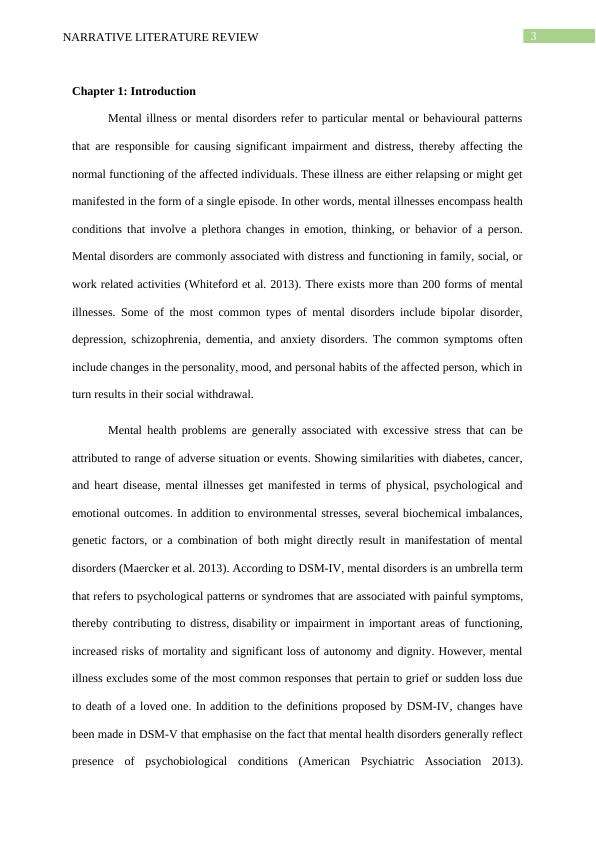
4NARRATIVE LITERATURE REVIEW
Furthermore, mental illnesses should not only be considered a direct result of conflicts with
the society or social deviance. There are several categories of mental disorder, which in turn
adversely affect different facets of personality and behaviour, thereby making them distorted.
Fear or anxiety generally interferes with the normal functioning of an individual and might
get categorised as an anxiety disorder. Some of the most commonly recognized categories
include generalized anxiety disorder, phobias, panic disorder, social anxiety
disorder, obsessive-compulsive disorder, agoraphobia, and post-traumatic stress disorder
(Nolen-Hoeksema and Rector 2015).
Mental illness most often result in distortions or disorientation in the functioning of
emotion and mood. Mood disorders encompass a group of mental conditions where the
person’s mood gets affected, in addition to onset of melancholia, sustained and intense
sadness, or despair. This is often categorised as major depressive disorder. Prolonged and
milder depression are also known as dysthymia that contains similar physical and cognitive
issues as faced in depression, but with longer-lasting symptoms. Another prevalent mental
illness is bipolar disorder or manic depression, which involves abnormal or unusual mood
states, and shifts in the activity levels and energy, that are manifested alternately with normal
moods (Yatham et al. 2013). Mental disorders are surprisingly prevalent among the youth and
children. Approximately one in seven youth suffer from mental illness at some point in their
lives. Mental illnesses are also universal, and affect individuals of all societies and countries,
regardless of their gender, income, and age. The point prevalence of such mental disorders
among adults at any time is approximately 10%. Similarly, an estimated 20% of all patients
who consult primary health care providers suffer from one or more mental illnesses (Reupert,
J Maybery and Kowalenko 2013).
Stigma and misunderstanding surrounding mental illness are quite widespread.
Despite presence of effective treatments for all mental illnesses, there exist perceptions and
Furthermore, mental illnesses should not only be considered a direct result of conflicts with
the society or social deviance. There are several categories of mental disorder, which in turn
adversely affect different facets of personality and behaviour, thereby making them distorted.
Fear or anxiety generally interferes with the normal functioning of an individual and might
get categorised as an anxiety disorder. Some of the most commonly recognized categories
include generalized anxiety disorder, phobias, panic disorder, social anxiety
disorder, obsessive-compulsive disorder, agoraphobia, and post-traumatic stress disorder
(Nolen-Hoeksema and Rector 2015).
Mental illness most often result in distortions or disorientation in the functioning of
emotion and mood. Mood disorders encompass a group of mental conditions where the
person’s mood gets affected, in addition to onset of melancholia, sustained and intense
sadness, or despair. This is often categorised as major depressive disorder. Prolonged and
milder depression are also known as dysthymia that contains similar physical and cognitive
issues as faced in depression, but with longer-lasting symptoms. Another prevalent mental
illness is bipolar disorder or manic depression, which involves abnormal or unusual mood
states, and shifts in the activity levels and energy, that are manifested alternately with normal
moods (Yatham et al. 2013). Mental disorders are surprisingly prevalent among the youth and
children. Approximately one in seven youth suffer from mental illness at some point in their
lives. Mental illnesses are also universal, and affect individuals of all societies and countries,
regardless of their gender, income, and age. The point prevalence of such mental disorders
among adults at any time is approximately 10%. Similarly, an estimated 20% of all patients
who consult primary health care providers suffer from one or more mental illnesses (Reupert,
J Maybery and Kowalenko 2013).
Stigma and misunderstanding surrounding mental illness are quite widespread.
Despite presence of effective treatments for all mental illnesses, there exist perceptions and
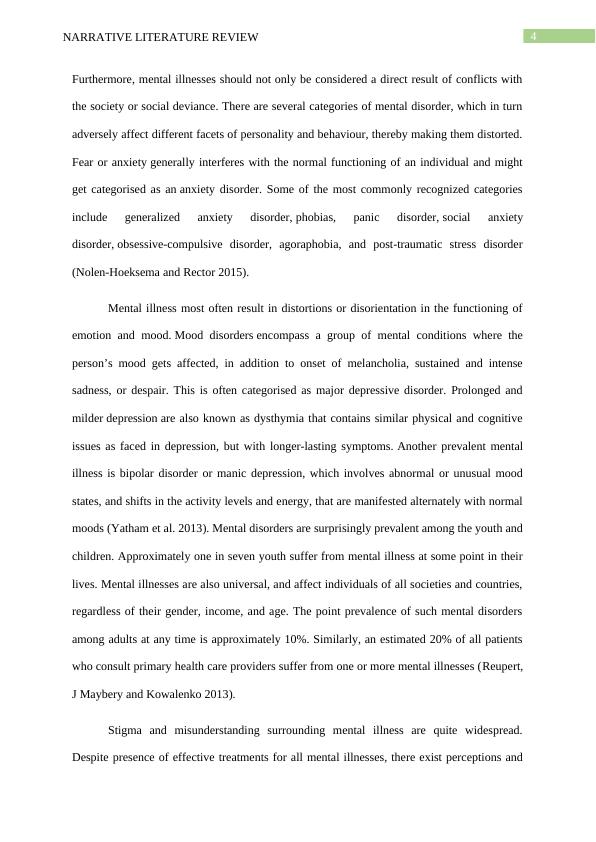
5NARRATIVE LITERATURE REVIEW
beliefs that they cannot be treated. Furthermore, one common conception is related to the fact
that people suffering from mental disorders lack common intelligence and are incapable of
making sound decisions. Such stigma often results in rejection, abuse, and isolation of the
disadvantaged people. Within the health system, people are too often treated in institutions
which resemble human warehouses rather than places of healing. Mental health stigma is
generally categorised into two different types, namely social stigma and perceived stigma
(Corrigan, Druss and Perlick 2014). ‘Social stigma’ is characterized by display of
‘discriminating behaviour’ and prejudicial attitudes, which are directed towards people with
poor mental health problems, as a direct manifestation of the psychiatric labels that they have
been bestowed with. In contrast, ‘self-stigma’ or ‘perceived stigma’ refers to the internalizing
of perceptions related to discrimination and prejudice, by the mental health sufferers, and are
found to significantly alter feelings of shame. These result in poor self-esteem and results in a
failure of the affected individuals to lead a successful and purposeful life.
Serious mental illness is therefore considered as two-edged sword. Public stigma
often comprises of reactions of general public towards groups that are biased on stigma about
the patients. Individuals generally fail to agree with the stereotypes that they are aware of.
However, individuals with mental illness, endorse the negative prejudice and stereotypes, as a
result of which they suffer from negative emotional consequences. Prejudice also results in
discrimination that gets manifested in the form of a behavioral reaction (Henderson, Evans-
Lacko and Thornicroft 2013). Such prejudice faced by the individuals, often yields anger,
which in turn can result in display of hostile behavior. In the case of mental disorders, angry
prejudice might also lead to replacing healthcare with criminal justice system or withholding
help. Fear often makes the affected people to adopt an avoidant behavior. Such instances are
most commonly seen in workplaces where the employers do not hire persons suffering from
mental illness. This association between the ‘perceived dangerousness’ of individuals with
beliefs that they cannot be treated. Furthermore, one common conception is related to the fact
that people suffering from mental disorders lack common intelligence and are incapable of
making sound decisions. Such stigma often results in rejection, abuse, and isolation of the
disadvantaged people. Within the health system, people are too often treated in institutions
which resemble human warehouses rather than places of healing. Mental health stigma is
generally categorised into two different types, namely social stigma and perceived stigma
(Corrigan, Druss and Perlick 2014). ‘Social stigma’ is characterized by display of
‘discriminating behaviour’ and prejudicial attitudes, which are directed towards people with
poor mental health problems, as a direct manifestation of the psychiatric labels that they have
been bestowed with. In contrast, ‘self-stigma’ or ‘perceived stigma’ refers to the internalizing
of perceptions related to discrimination and prejudice, by the mental health sufferers, and are
found to significantly alter feelings of shame. These result in poor self-esteem and results in a
failure of the affected individuals to lead a successful and purposeful life.
Serious mental illness is therefore considered as two-edged sword. Public stigma
often comprises of reactions of general public towards groups that are biased on stigma about
the patients. Individuals generally fail to agree with the stereotypes that they are aware of.
However, individuals with mental illness, endorse the negative prejudice and stereotypes, as a
result of which they suffer from negative emotional consequences. Prejudice also results in
discrimination that gets manifested in the form of a behavioral reaction (Henderson, Evans-
Lacko and Thornicroft 2013). Such prejudice faced by the individuals, often yields anger,
which in turn can result in display of hostile behavior. In the case of mental disorders, angry
prejudice might also lead to replacing healthcare with criminal justice system or withholding
help. Fear often makes the affected people to adopt an avoidant behavior. Such instances are
most commonly seen in workplaces where the employers do not hire persons suffering from
mental illness. This association between the ‘perceived dangerousness’ of individuals with
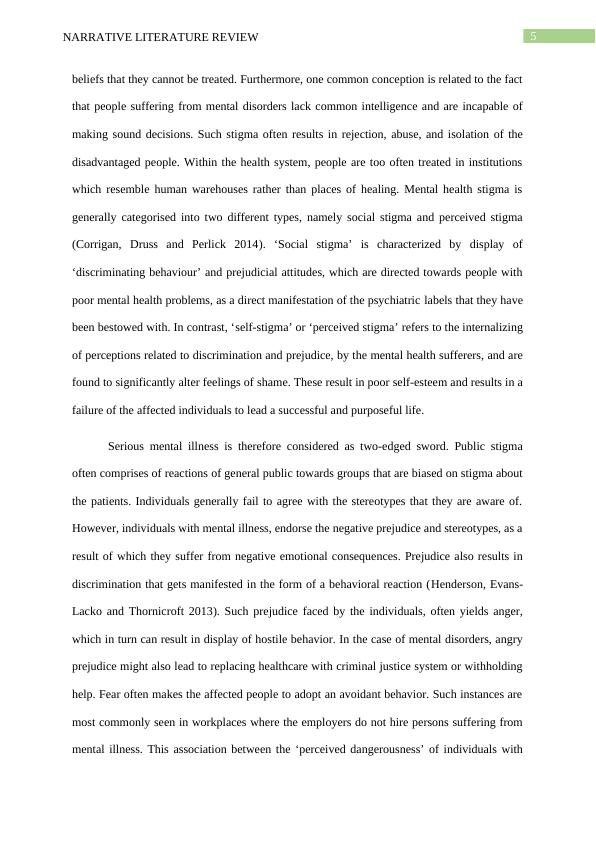
6NARRATIVE LITERATURE REVIEW
mental illness, and increased ‘social distance’ result in negative health outcomes and also acts
as barriers in the process of mental health recovery. In other words, public health stereotypes
comprise of three basic elements such as, prejudice, stigma and discrimination, in the context
of power difference, which brings about changes in the reaction of the general public towards
the stigmatised individuals (Parcesepe and Cabassa 2013). The narrative literature review will
try to evaluate the impacts of such mental health stigma and prejudice at the workplace of
people aged 25-40 years, suffering from mental illness, in England.
mental illness, and increased ‘social distance’ result in negative health outcomes and also acts
as barriers in the process of mental health recovery. In other words, public health stereotypes
comprise of three basic elements such as, prejudice, stigma and discrimination, in the context
of power difference, which brings about changes in the reaction of the general public towards
the stigmatised individuals (Parcesepe and Cabassa 2013). The narrative literature review will
try to evaluate the impacts of such mental health stigma and prejudice at the workplace of
people aged 25-40 years, suffering from mental illness, in England.

7NARRATIVE LITERATURE REVIEW
Chapter 2: Background and Rationale
Context of the study
Mental health problems are considered one of the major causes that contribute to the
global disease burden. Mental illness and behavioural problems such as, anxiety, depression,
and substance use have been identified as the primary drivers of global disability, which in
turn contributes to more than 40 million years of disability among people aged 20 to 29 years.
Major depression has also been recognised as the second leading cause of disability and is
thought to be a primary factor that results in an increase in the worldwide burden of suicidal
ideations (Yang et al. 2014). Working environment and conditions create huge impacts on the
mental health of the employees. Statistical reports also stated that approximately 1 in
6.8 people are more susceptible to experiencing a range of mental health problems at their
workplace (14.7%). Women engaged in full-time employment are found to be nearly twice
prone to suffer from common mental health problems, upon comparison to full-time
employed men (19.8% and 10.9%, respectively). Evidences also suggest that an
estimated 12.7% of all sickness related absence days in the UK are directly correlated to poor
mental health conditions (Mental Health Foundation 2018). There is a need for all work
organizations to fulfil their responsibility of providing support to individuals with mental
illnesses. Research evidences have established strong association between long term
unemployment and the associated detrimental impacts that it creates on the mental health of
the affected individuals.
Results from a survey indicated that 40% of employees feared that revealing presence
of some mental health disorder at their workplace, might jeopardise their career (ONS
2014). The survey was conducted among 2,000 workers, and was commissioned by the
Mental Health Foundation. Findings indicated that approximately 40% of the workers were
Chapter 2: Background and Rationale
Context of the study
Mental health problems are considered one of the major causes that contribute to the
global disease burden. Mental illness and behavioural problems such as, anxiety, depression,
and substance use have been identified as the primary drivers of global disability, which in
turn contributes to more than 40 million years of disability among people aged 20 to 29 years.
Major depression has also been recognised as the second leading cause of disability and is
thought to be a primary factor that results in an increase in the worldwide burden of suicidal
ideations (Yang et al. 2014). Working environment and conditions create huge impacts on the
mental health of the employees. Statistical reports also stated that approximately 1 in
6.8 people are more susceptible to experiencing a range of mental health problems at their
workplace (14.7%). Women engaged in full-time employment are found to be nearly twice
prone to suffer from common mental health problems, upon comparison to full-time
employed men (19.8% and 10.9%, respectively). Evidences also suggest that an
estimated 12.7% of all sickness related absence days in the UK are directly correlated to poor
mental health conditions (Mental Health Foundation 2018). There is a need for all work
organizations to fulfil their responsibility of providing support to individuals with mental
illnesses. Research evidences have established strong association between long term
unemployment and the associated detrimental impacts that it creates on the mental health of
the affected individuals.
Results from a survey indicated that 40% of employees feared that revealing presence
of some mental health disorder at their workplace, might jeopardise their career (ONS
2014). The survey was conducted among 2,000 workers, and was commissioned by the
Mental Health Foundation. Findings indicated that approximately 40% of the workers were
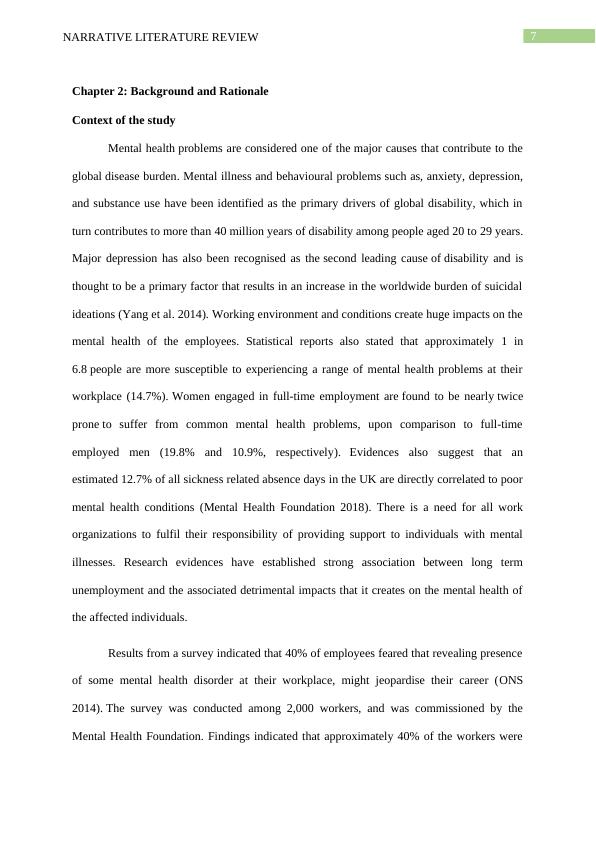
End of preview
Want to access all the pages? Upload your documents or become a member.
Related Documents
Standard 6 of Practice in Mental Health Nursing: Eliminating Stigma and Encouraging Inclusionlg...
|8
|2244
|373
Social Stigma Related to Depression; Its Impact on Treatment Seeking Attitudes (Social Stigma Related to Depression; Its Impact on Treatment Seeking Attitudes)lg...
|27
|8430
|106
Stigma Influence on Mental Illness the Recoverylg...
|5
|1454
|15
Risk and Protective Factors for Psychotic Disorders Among Young Men Aged 16-25 in the UKlg...
|30
|11790
|20
Understanding Mental Illness: Factors, Epidemiology, and Interventionslg...
|12
|2658
|76
Research Project on Minority Face Employment in NHS Englandlg...
|23
|6264
|25
